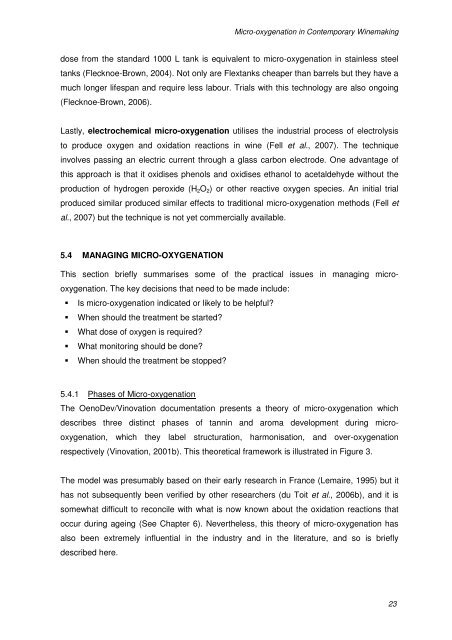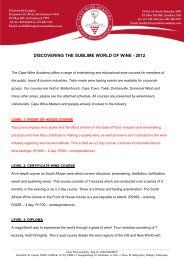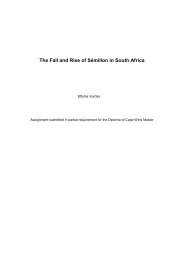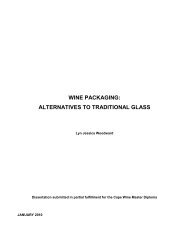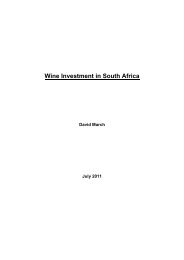micro-oxygenation in contemporary winemaking - Cape Wine ...
micro-oxygenation in contemporary winemaking - Cape Wine ...
micro-oxygenation in contemporary winemaking - Cape Wine ...
Create successful ePaper yourself
Turn your PDF publications into a flip-book with our unique Google optimized e-Paper software.
Micro-<strong>oxygenation</strong> <strong>in</strong> Contemporary W<strong>in</strong>emak<strong>in</strong>gdose from the standard 1000 L tank is equivalent to <strong>micro</strong>-<strong>oxygenation</strong> <strong>in</strong> sta<strong>in</strong>less steeltanks (Flecknoe-Brown, 2004). Not only are Flextanks cheaper than barrels but they have amuch longer lifespan and require less labour. Trials with this technology are also ongo<strong>in</strong>g(Flecknoe-Brown, 2006).Lastly, electrochemical <strong>micro</strong>-<strong>oxygenation</strong> utilises the <strong>in</strong>dustrial process of electrolysisto produce oxygen and oxidation reactions <strong>in</strong> w<strong>in</strong>e (Fell et al., 2007). The technique<strong>in</strong>volves pass<strong>in</strong>g an electric current through a glass carbon electrode. One advantage ofthis approach is that it oxidises phenols and oxidises ethanol to acetaldehyde without theproduction of hydrogen peroxide (H 2 O 2 ) or other reactive oxygen species. An <strong>in</strong>itial trialproduced similar produced similar effects to traditional <strong>micro</strong>-<strong>oxygenation</strong> methods (Fell etal., 2007) but the technique is not yet commercially available.5.4 MANAGING MICRO-OXYGENATIONThis section briefly summarises some of the practical issues <strong>in</strong> manag<strong>in</strong>g <strong>micro</strong><strong>oxygenation</strong>.The key decisions that need to be made <strong>in</strong>clude: Is <strong>micro</strong>-<strong>oxygenation</strong> <strong>in</strong>dicated or likely to be helpful? When should the treatment be started? What dose of oxygen is required? What monitor<strong>in</strong>g should be done? When should the treatment be stopped?5.4.1 Phases of Micro-<strong>oxygenation</strong>The OenoDev/V<strong>in</strong>ovation documentation presents a theory of <strong>micro</strong>-<strong>oxygenation</strong> whichdescribes three dist<strong>in</strong>ct phases of tann<strong>in</strong> and aroma development dur<strong>in</strong>g <strong>micro</strong><strong>oxygenation</strong>,which they label structuration, harmonisation, and over-<strong>oxygenation</strong>respectively (V<strong>in</strong>ovation, 2001b). This theoretical framework is illustrated <strong>in</strong> Figure 3.The model was presumably based on their early research <strong>in</strong> France (Lemaire, 1995) but ithas not subsequently been verified by other researchers (du Toit et al., 2006b), and it issomewhat difficult to reconcile with what is now known about the oxidation reactions thatoccur dur<strong>in</strong>g age<strong>in</strong>g (See Chapter 6). Nevertheless, this theory of <strong>micro</strong>-<strong>oxygenation</strong> hasalso been extremely <strong>in</strong>fluential <strong>in</strong> the <strong>in</strong>dustry and <strong>in</strong> the literature, and so is brieflydescribed here.23


